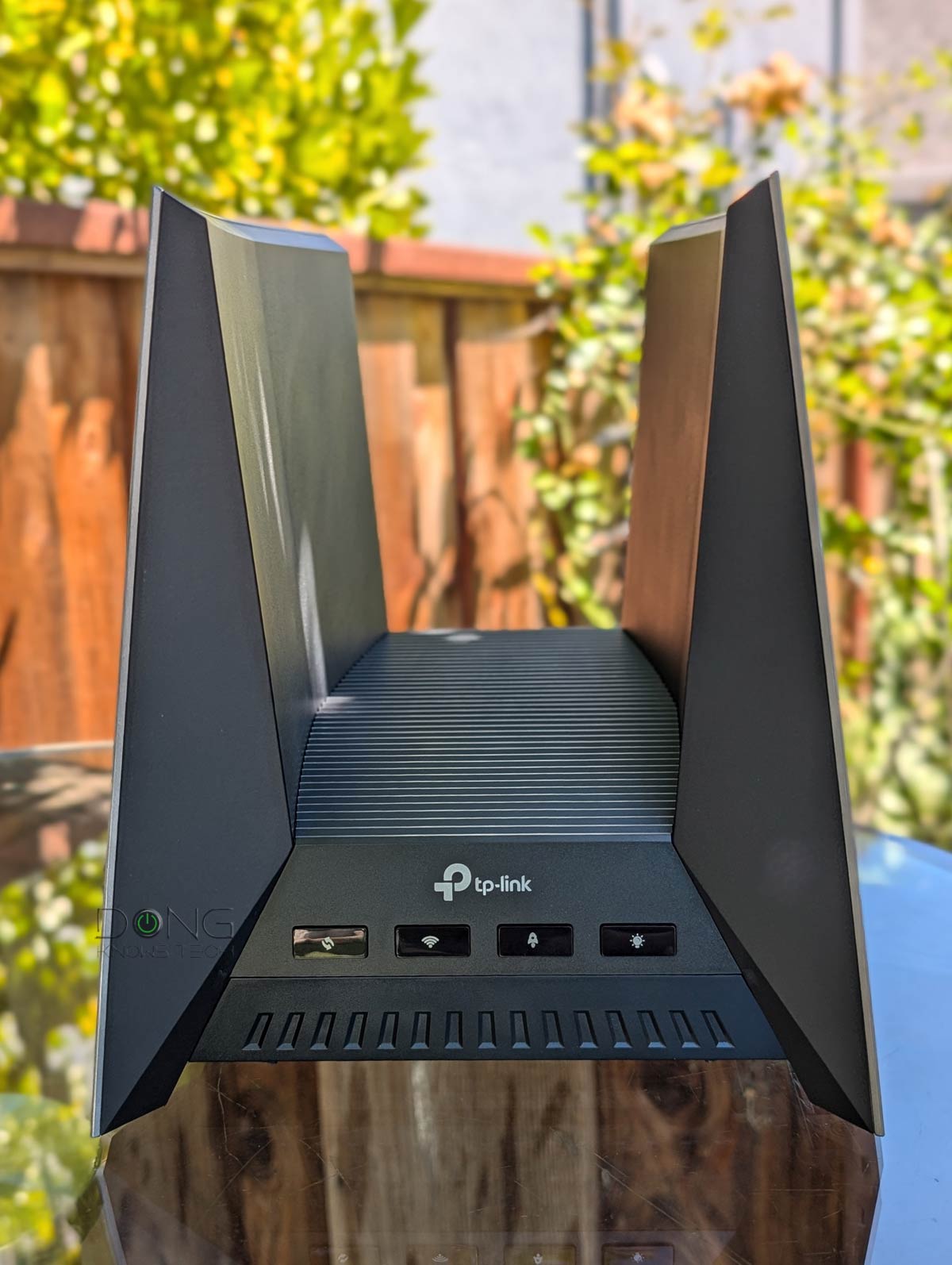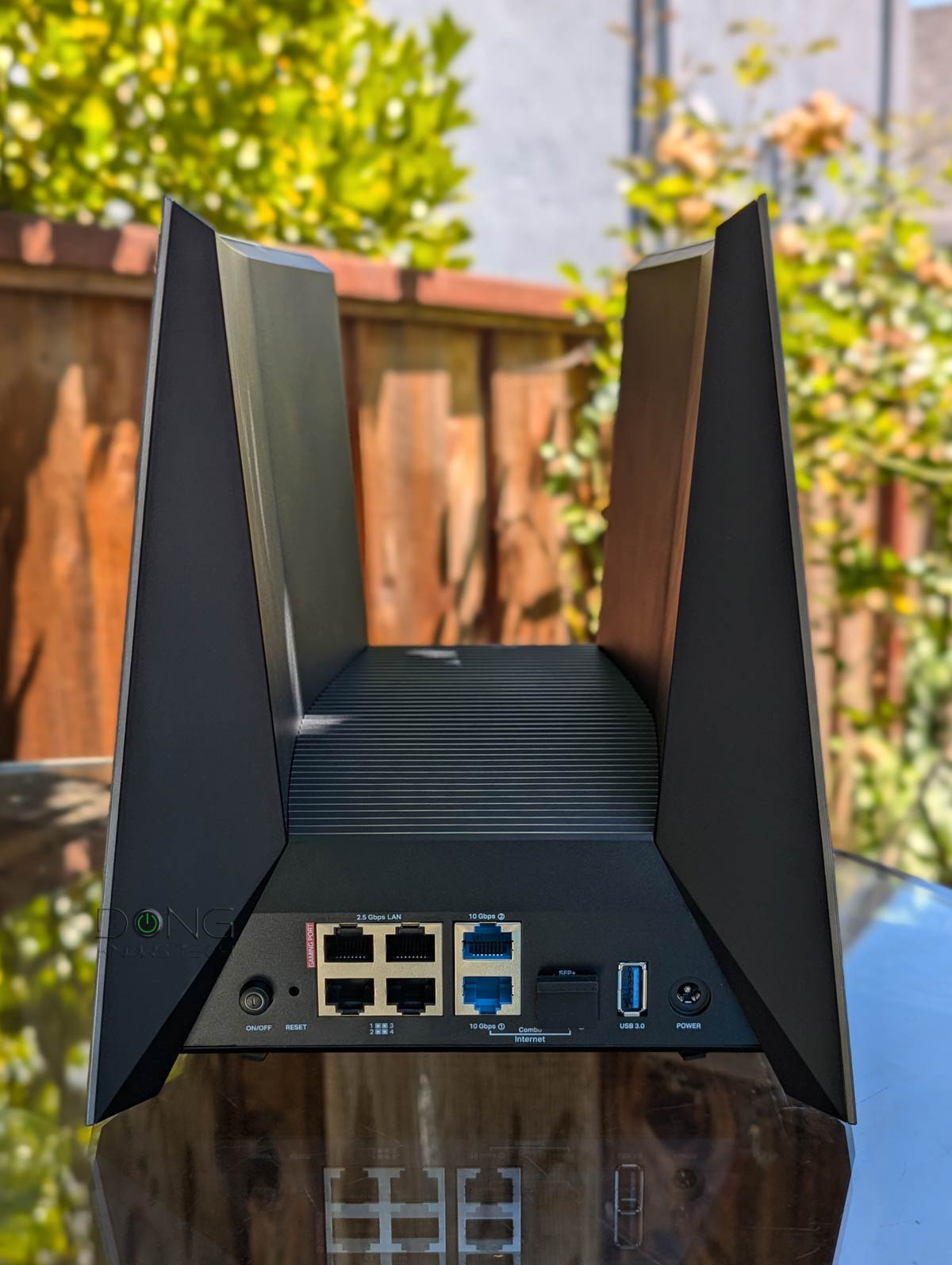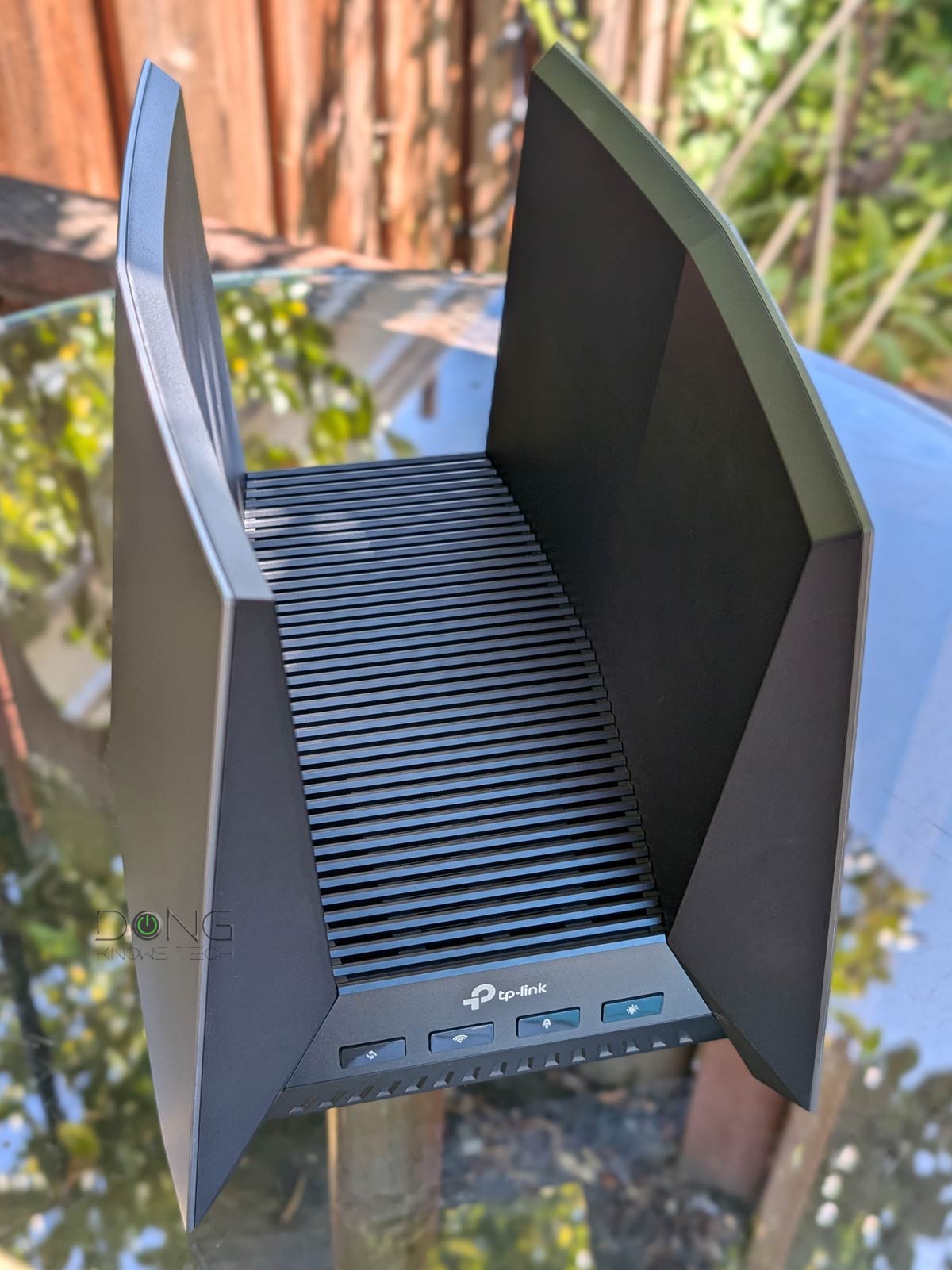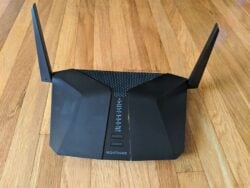The Archer GE800, unveiled during CES 2024, is finally available for purchase today, and it’s the most exciting router in TP-Link’s Archer family.
The new and massive tri-band BE19000 tri-band Wi-Fi 7 machine has best-in-class performance that matches its top-tier hardware specs. It also looks fantastic, at least to some.
Here’s the bottom line: If you’re in the market for a Wi-Fi 7 router that can handle bandwidth-intensive tasks as well as gaming-specific needs, the TP-Link Archer GE800, with its flaws, is a safe buy, especially when considering its comparatively friendly suggested retail price of $599.99. It’s the best router TP-Link has made to date.
Deal alert!
During the launch period, which lasts until July 15, the Archer GE800 is available on Amazon with a $100 discount.
On the other hand, if you want a slightly more refined Wi-Fi experience of similar caliber, the more expensive Asus GT-BE98 Pro is a better fit. Or maybe hold up to see how the upcoming GT-BE19000 will pan out.

Archer GE800: A massive Wi-Fi 7 router for gamers and home users alike
The Archer GE800 is, at least, the third “gaming” router from TP-Link I’ve had my hands on, after the Archer AX11000 and GX90. However, it’s actually the very first true hardware of its type.
That’s because the previous two are more gaming routers in name only, with little to offer other than the flashy design. This time around, the Archer GE800 comes with actual gaming features similar to those of Asus’s ROG Rapture lineup. Here are the its game-related features, per TP-Link:
- Game Acceleration:
- Accelerate game applications with QoS
- Accelerate game devices with a 2.5Gbps Gaming Port
- Game server acceleration by Game Private Network (GPN)
- Accelerate mobile games
- One-Click acceleration button
- Game Panel:
- Network status
- Router performance
- RGB light settings
- Accelerated games and gears
- Game Statistics: Comprehensive gaming traffic reports
- Gaming Band: The 5 GHz band can be dedicated to gaming
I spent some time trying most of these out, and some proved to actually play a helpful role in making setting up the network for gaming an easier job.
For example, the game acceleration feature basically provides quick QoS settings for certain games. Pick a game, and the system will set the best setting for it. Additionally, the router can detect, correctly most of the time during my trial, the games played by devices in the network and allows users to apply the best setting via a few clicks.
There’s also a convenient game port, which is the router’s first 2.5Gbps LAN port. Connect a device to this port, and it’ll be automatically prioritized for gaming. Need more than one wired device? Use a switch with this port.
Additionally, the support for GPN allows those with an account with WTFast to associate the router with it, allowing all consoles within the network to be part of the GPN automatically. It’s worth noting that WTFast is not free and is applicable to only certain types of games. Still, the support for this type of special connection is part of what qualifies the GE800, in my book, as an actual gaming router.
But like all gaming routers, other features are gimmicks, albeit fun ones, such as the design and the RGB programmable lighting.


A new design that continues TP-Link’s complete multi-gigabit approach
Indeed. The TP-Link Archer GE800 doesn’t lag behind in terms of look. The new router comes with a completely new design that takes the shape of a landed Upsilon-class command shuttle in Star Wars. It has two wings on the sides, each equipped with programmable “dynamic RGB lighting”.
While cool at a glance, the design can be an eyesore, depending on who you ask—it might not pass that “wife approval” challenge—and has a couple of drawbacks.
First, while massive, most of the router’s physical size is made up of the two vertical “wings”—from above, the whole thing looks like gigantic double cup holders—and the actual “body,” where the circuit board and processing unit reside, remains relatively compact. As a result, TP-Link has to use a thermal solution with an internal fan. And moving parts like fans are never a good thing.
Second, on the front, there’s an array of four hardware buttons for WPS initialization, Wi-Fi on/off, Game Acceleration, and the LED light effect. These buttons can be a bit impractical. Other than the WPS that works with a simple press, the rest require a 2-second press and hold to take effect. Still, their easily accessible locations make them susceptible to accidental touching or fiddling.
During the testing, I left the router in our living room for a day, and our 2.5-year-old messed around with these buttons so much—the intriguing RGB lighting was part of the blame—that I ended up having to reset the router to start from scratch to make sure.
Overall, considering the web user interface and the Tether mobile app, these buttons are simply unnecessary.
To make up for these design flaws, on the wired networking front, like the case of the Archer BE800, the Archer GE800 is great.
It has two 10Gbps Multi-Gig ports—one is a BASE-T/SFP+ combo—and four 2.5Gbps LAN ports, of which one can be dedicated to gaming as the Game Port. Any device connected to this port will be automatically prioritized, and you can even connect a switch to it to increase the number of prioritized wired gaming devices.
At the very least, with that number of multi-Gigabit ports, a single Archer GT800 unit is enough to turn most home networks into full multi-Gigabit before the use of a switch. And that’s always a good thing.
As for Wi-Fi, the Archer GE800 features top-tier tri-band Wi-Fi 7 with a total wireless bandwidth of up to 19000Mbps. It’s in the same class as the Asus RT-BE96U, though it is more of a rival to the upcoming GT-BE19000. The table below shows its specs vs. those of the Asus, including the quad-band GT-BE98 Pro I reviewed recently.


Hardware specifications: Archer GE800 vs. Asus GT-BE19000 vs. Asus GT-BE98 Pro
 |  |  | |
|---|---|---|---|
| Model | TP-Link Archer GE800 | Asus GT-BE1900 | Asus GT-BE98 Pro |
| Dimensions | 11.5 × 8.1 × 8.8 in (292 × 207 × 224 mm) | 11.9 × 10.3 × 3.8 in (302 × 262.5 × 96 mm) | 9.1 × 9.1 × 2.7 in (232 × 232 × 68 mm) |
| Weight | TBD | ?4.78 lbs (2.16 kg) | 3.75 lbs (1.7 kg) |
| Processing Power | Quad-core CPU, 2GB RAM | Quad-core 2.6GHz CPU, 256MB Flash, 2GB RAM | |
| Wi-Fi Bandwidth | Tri-band BE19000 | Quad-band BE30000 | |
| 1st Band (channel width) | 4×4 2.4GHz BE: Up to 1376Mbps (20/40MHz) | ||
| 2nd Band (channel width) | 4×4 5GHz BE: Up to 5760Mbps (20/40/80/160MHz) | ||
| 3rd Band (channel width) | 4×4 6GHz BE: Up to 11520Mbps (20/40/80/160/320MHz) | 4×4 6GHz-1 BE: Up to 11520Mbps (20/40/80/160/320MHz) | |
| 4th Band (channel width) | None | 4×4 6GHz-2 BE: up to 11525Mbps (20/40/80/160/320MHz) | |
| Backward Compatibility | 802.11a/b/g/n/ac/ax/axe Wi-Fi | ||
| Wireless Security | WPA / WPA2 / WPA3 | ||
| Multi-Link Operation (MLO) | Yes | ||
| Automated Frequency Coordination (AFC) | Not at launch (to be added via firmware) | Yes | Not at launch (to be added via firmware) |
| Web User Interface | Yes | ||
| Mobile App | TP-Link Tether (optional) | Asus Router (optional) | |
| Real Gaming-Related Features | Yes | ||
| Operating Roles | Router (default) or Access Point | Router Access Point Repeater Media Bridge | |
| Mesh-Ready | Yes (EasyMesh) | Yes (AiMesh) | |
| USB Port | 1x USB 3.0 | ||
| Gigabit Port | None | 1x LAN | |
| Multi-Gig Port | 1× 10GBASE-T 1x 10GBASE-T/SFP+ Combo 4× 2.5 2.5GBASE-T | 2x 10GBASE-T 4x 2.5GBASE-T | |
| Link Aggregation | Yes | ||
| Dual-WAN | No | Yes | |
| VPN Server Support | OpenVPN, PPTP, L2TP/IPSec, WireGuard | OpenVPN, PPTP, L2TP/IPSec, WireGuard, Instant Guard, VPN Fusion | |
| VPN Client Support | Yes (standard and WTFast GPN) | ||
| VLAN | VLAN tagging only | VLAN tagging, Advanced VPN and Guest Network Pro with AsusWRT 5.0 | |
| Power Input | 100-240V | ||
| Power Consumption (per 24 hours) | ≈585 Wh (as tested) | not yet tested | ≈560 Wh (as tested) |
| Release Date | June 27, 2024 | July 2024 | Q1 2024 |
| Firmware (at review) | 1.1.3 Build 20240528 rel.85215(5553) | (not yet reviewed) | 3.0.0.6.102_32882 |
| US MSRP | $599.99 | $749 | $799.99 |


A familiar Archer router
Despite the added gaming features and the all-new design, on the inside, the GE800 is a familiar Archer router, albeit with a more flashy theme for its web user interface to show that it’s a gaming router.
In particular, it has a standard web user interface accessible via the default IP address, common in most, if not all, TP-Link routers, which is 192.168.0.1. Navigate a computer connected to this address, and you can get the router up and running in a few minutes, the way you set up any standard Wi-Fi router.
After that, apart from the gaming features mentioned above, the router has the standard set of networking features, including Dynamic DNS, port forwarding, VPN (server or client), and all options for WAN access (dynamic, statics, PPPoE, etc.) Addtionally, it comes with the basic version of HomeShield, which includes QoS and lights parental control, with a more advanced version and online protection available via premium add-ons.


Straightforward MLO and SSID options, no AFC yet
As a Wi-Fi 7 router, it supports the MLO feature right out of the box. As mentioned in the primer post on the Wi-Fi standard, TP-Link generally allows users to create a virtual MLO SSID on top of the main SSID(s). That said, the Archer BE800 gives you the following options for its Wi-Fi network:
- A primary SSID for each of the three bands, or you can use one for all of them (Smart Connect).
- An MLO SSID for all or any two of the three bands.
- A Guest SSID for each of the bands.
On the other hand, like all existing TP-Link Wi-Fi 7 broadcasters, the Archer GE800 doesn’t have AFC yet. TP-Link says it will add this crucial feature that increases the range of the 6GHz band to its hardware later this year via firmware updates.
Without AFC, it’s expected that the router’s 6GHz band has a noticeably shorter range than that of the 5GHz. Still, the router performed excellently in my testing.


TP-Link Archer GE800: Overall excellent performance
I tested the router for over a week as a standalone router and was overall happy with its performance. The router passed the three-day stress test without disconnection, which is always a good sign. Its range was great, too, about the same as that of the RT-BE96U.


It’s hard to put Wi-Fi coverage in a concrete number, but if you live in a home of around 2500 ft2 (232 m2) without crazy thick walls, the router likely will cover every corner when placed in the middle. Your mileage will vary, and note the different ranges of its bands. When (or if) AFC is available, you can expect the range of the 6GHz band to be the same as that of the 5GHz.

In terms of throughput, the Archer GE800 did exceptionally well as a wired router. Its multi-Gigabit ports have delivered top performance to date, and when hosting a portable SSD, it also delivered the best-sustained copy speeds among all Wi-Fi 7 routers.
As for Wi-Fi, the real-world performance was also among the best to date.


A bit hot, a tad noisy
As mentioned, the TP-Link Archer GE800 was far from perfect.
During my weeklong trial, it ran pretty hot. I could feel the heat coming out of its top, between the “wings”. Additionally, its fan ran constantly and produced a noticeable hum, which can be a nuisance in a quiet room. Overall, it reminded me of the router unit in the Deco BE85, which also had a relatively loud fan that ran all the time.
Judging from the Deco, which I have been using a few sets since the review, chances are the fan and heat issues won’t affect the Archer GE800’s reliability, at least not in the first year. Still, it’s best to leave it in an open space, preferably far from the reach of your small children.

TP-Link Archer GE800's Rating

Pros
Top-tier tri-band Wi-Fi 7 specs with full multi-Gigabit to deliver excellent real-world performance
Robust web user interface with an excellent set of network features and Wi-Fi settings, including MLO and gaming-related features
Competitively priced; useful (optional) mobile app; EasyMesh-ready; cool-looking design
Cons
Bulky design with audible internal fan; runs hot; Wi-Fi throughputs could be comparatively a tad better
No AFC (at launch); online protection and advanced parental controls require subscriptions
Not wall-mountable
Conclusion
The Archer GE800 BE19000 Tri-Band Wi-Fi 7 Gaming Router is arguably the best standalone router TP-Link has made to date. While it’s not the best among its peers, it’s, so far, the most affordable, especially during the launch, where buyers could take advantage of the generous $100 discount on Amazon. If you can overlook the bulky design and the internal fan, there’s no reason why you won’t end up happy with it. And, like most other Wi-Fi 7 broadcasters on the market, it’ll likely only get better over time via future firmware updates. Consider one today!






Hi Dong
I’ve just bought the GE800 , Overall it’s a great device,but it has some minor issues which I believe would be solved with firmware updates. My biggest issues with the router , the wifi speed, in some rooms, around 6 metes far, with no less than 75% signal , the speed is very slow, 3-5MB .
My older Archer AC5200 was doing better job.
even before buying the router, i read your review and many others for both GE800 and Asus GT-BE98 Pro, it was hard to decide between them.
So , if I switch to the Asus GT-BE98 Pro , am I gonna get better Wifi speed and coverage , are the gaming features much different, and the free features like protection, is it worth it to do the switch?
thank you
The GT-BE98 Pro is overall much better, Yousef. However, your issue with Wi-Fi speed seemed unrelated. Chances are you were using the 2.4GHz band, or MLO. Generally a router does much better with clients of the same Wi-Fi standard than another router of newer Wi-Fi standard. More on testing in this post.
Nice Updated Qualcomm 1220.
I highly value privacy and web interfaces so I am torn between this and the Asus GT-BE98 Pro. It seems like the GE800 is far cheaper for a similar experience. Would you recommend one of the other considering the cost difference? I’m leaning on ordering the GE800 with the $100 discount right now
They are two different grades, Zac. The GT-BE98 Pro is a quad-band router with lots more features, all free. This one is a Tri-band with fewer free features. In terms Wi-Fi expereince, they are similar.
Hi Dong,
I have a few questions about this.
1. Does this have the issues that other TP-Link devices have, where you can’t actually turn off the router DHCP server? I have a Windows server I prefer handing out DHCP addresses in my home/lab network.
2. Does it rely on the app well, and are there the privacy concerns of having a TP-Link account to access the devices? Or are they entirely web-based and can be managed from the internal network?
3. Does it support advanced networking features like VLANs, VPN, etc?
4. Will the 10 Gb port work as a 2.5 Gb port as well? Fios is only 1 Gb here.
I currently have a Fios CR1000A with 2 E3200 extenders running over coax and I’m pretty limited on what I can, so I’m looking for something to replace them that preferably won’t break the bank.
Thanks!
Tosan,
1. You can turn the DHCP server off on this one.
2. Read the review.
3. Read the review.
4. If you use the 10GBASE-T port. More on Multi-Gig in this post.
Thanks. Not sure how I missed the VLAN thing.
I had heard from someone that some 10 gig ports won’t support 2.5 gb, or 5 gb – they’ll skip down to 1 gb.
I take it the new Decos still require the TPLink account?
Yeap. More on Deco in this post.
call me crazy for these thoughts.
I have a 2.5 gig plan, a BE9300 Tri-Band Wi-Fi 7 Router, and 10 gig ports on my macs. I always get 2.35 on speedtest.
If i got this router and ran it thru its 10 gig port could i get “true 2.5 internet”?
thanks
Yes, Paul. You’re not crazy.
To get a wired grade in full (after overhead) you need to use a faster grade. So for your case, this Archer GE800 or the BE800 is the way to go. I’d go with this one, though.
Or you can get any other router with two or more 10Gbps ports. It gets tricky when you have 10Gbps broadband.
thank-you
👍